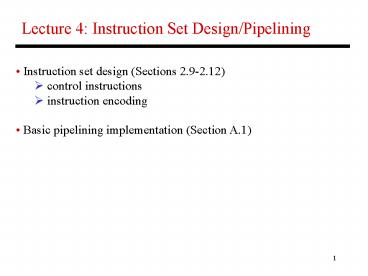Lecture 4: Instruction Set DesignPipelining PowerPoint PPT Presentation
Title: Lecture 4: Instruction Set DesignPipelining
1
Lecture 4 Instruction Set Design/Pipelining
- Instruction set design (Sections 2.9-2.12)
- control instructions
- instruction encoding
- Basic pipelining implementation (Section A.1)
2
Control Transfer Instructions
- Conditional branches (75 - Int) (82 - FP)
- Jumps (6 - Int) (10 - FP)
- Procedure calls/returns (19 - Int) (8 - FP)
- Design issues
- How do you specify the target address?
- How do you specify the condition?
- What happens on a procedure call/return?
3
Specifying the Target Address
- PC-Relative needs fewer bits to encode,
independent of - how/where the compiled code is linked, used for
branches - and jumps typically, the displacement needs
4-8 bits - Register-indirect jumps the address is not
known at - compile-time and has to be computed at run-time
(note can - use any other addressing mode too)
- procedure returns
- case statements
- virtual functions
- function pointers
- dynamically shared libraries
4
Specifying the Condition
5
Procedure Call/Returns
- Need to maintain a stack of return addresses (in
memory or - in hardware)
- Can copy and save all registers together or this
can be done - selectively
- Who is responsible for saving registers?
- Caller saving correctness issues (global
register has to - be made available to other procedures), it
only saves - values that it cares about
- Callee saving it saves only as many registers
as it - needs (provided it doesnt call other
procedures) - A combination of both is typically employed
6
Instruction Set Encoding
- Operations are easy to encode efficiently the
key issues - are the number of operands and their
addressing modes - Few addressing modes ? low complexity in
decoding and - pipelining, but greater code size
- Fixed instruction lengths ? low complexity in
decoding, but - greater code size
7
Instruction Lengths
8
Dealing with Code Size in RISC
- Some hybrid versions allow for 16 and 32-bit
instructions - (40 reduction in code size) useful for
embedded apps - IBM PowerPC stores 32-bit instructions in
compressed - form in memory more hardware complexity on an
I-cache - miss (need to translate from uncompressed to
compressed - in addition to virtual to physical)
- Reducing the register file size can also reduce
the - instruction length
9
Compiler Optimizations
- The phase-ordering problemearly phases have to
assume that - register allocation will find a register, else,
optimizations such as - common subexpression elimination may increase
memory traffic
10
Register Allocation Issues
- Graph coloring determine when variables are
live and - avoid allocating the same register to variables
that are - simultaneously live
- Stack variables (typically local to a
procedure) easy to - allocate registers for
- Global data can be accessed from multiple
places (aliasing), - difficult to allocate to registers
- Heap data dynamically created objects, accessed
with - pointers, difficult to allocate to registers
because of aliasing
11
Case Study The MIPS ISA
- Load-store architecture
- Focus on pipelining, decoding, and compiler
efficiency - In other words, RISC
12
Registers
- 32 GPRs (general-purpose/integer registers) and
32 FPRs - 64-bit registers two single-precision FP values
can fit in - one register
- Register R0 is hardwired to zero with
displacement - addressing mode, we can also accomplish
absolute - addressing other uses for R0?
13
Instruction Format
14
Control Instructions
- Comparisons with zero can happen as part of the
branch - Compares between registers are placed in other
registers - that are tested by branches
- Jump-and-link places the return address in
register R31
15
Instruction Frequencies
16
Summary
- In the 1960s, stack architectures were
considered a good - match for high-level languages
- In the 1970s, software costs were a concern
ISAs were - enriched to make the compilers job easier
CISC - In the 1980s, there was a push for simpler
architectures - high clock speed and high parallelism RISC
- ISAs designed in 1980 are still around!
17
The Assembly Line
Unpipelined
Start and finish a job before moving to the next
Jobs
Time
A
B
C
Break the job into smaller stages
A
B
C
A
B
C
A
B
C
Pipelined
18
Performance Improvements?
- Does it take longer to finish each individual
job? - Does it take shorter to finish a series of jobs?
- What assumptions were made while answering these
- questions?
- Is a 10-stage pipeline better than a 5-stage
pipeline?
19
Title
- Bullet

